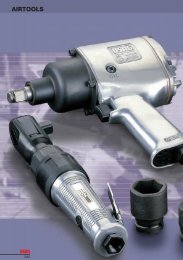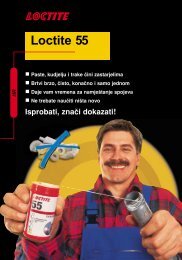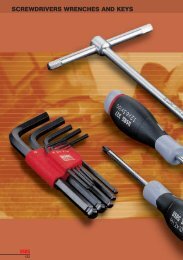Industrial seal self study guide - SKF.com
Industrial seal self study guide - SKF.com
Industrial seal self study guide - SKF.com
You also want an ePaper? Increase the reach of your titles
YUMPU automatically turns print PDFs into web optimized ePapers that Google loves.
SEAL DESIGN GROUPS (cont.)<br />
HSF<br />
SBF<br />
All rubber <strong>seal</strong>s do not score the<br />
bore after repeated installations<br />
and extractions. This prevents<br />
damage to the metal that can<br />
cause bypass leakage (fig. 3z).<br />
Slotted washer installed between<br />
<strong>seal</strong>s provides room for extra<br />
lubrication when needed (fig. 3aa).<br />
A<br />
SBF<br />
B<br />
SBF and HSF<br />
The <strong>SKF</strong> family of all-rubber <strong>seal</strong>s includes metal inserted (SBF)<br />
and fabric reinforced (HSF) products (fig. 3z). The fabric-reinforced<br />
series is available as solid round or with an open joint (split). When<br />
required by customers, they can be used interchangeably with all<br />
rubber HS types and are often found in imported heavy industry<br />
machinery. The inserted SBF type is an alternative to solid HS or<br />
HSF all rubber <strong>seal</strong>s that eliminates the need for a cover plate.<br />
All-rubber <strong>seal</strong>s do not score the bore even after repeated installations<br />
and extractions. This prevents damage to the metal that can cause<br />
bypass leakage. All rubber-<strong>seal</strong>s accept rougher bore finishes, reducing<br />
machining costs. They are especially helpful for split housings. They<br />
resist corrosion and will not seize in the bore even years after assembly.<br />
Multiple Split Seat Installation<br />
When split <strong>seal</strong>s are used in multiples, it is necessary to separate the<br />
<strong>seal</strong>s and provide extra lubrication between them. For the best results,<br />
a slotted washer should be fabricated and installed between the <strong>seal</strong>s<br />
(fig. 3aa). <strong>SKF</strong> does not supply slotted washers.<br />
For best performance, multiple split <strong>seal</strong>s should have staggered<br />
butt joints, for example: one joint at 10 o’clock, the other at 2 o’clock.<br />
V-Rings<br />
The V-Ring is an all-rubber <strong>seal</strong> that mounts directly on the shaft<br />
by hand, and is then pushed axially against a counterface, housing,<br />
bearing race or similar surface. Usually made of nitrile or flouroelastomers,<br />
other <strong>com</strong>pounds may be obtained on special orders.<br />
Designed with a long flexible lip, it acts like a mechanical face<br />
<strong>seal</strong>, or a flinger. The V-Ring can be used as the primary <strong>seal</strong> or<br />
as a back-up <strong>seal</strong>, to retain lubricants or exclude contaminants. The<br />
V-Ring, which has very high surface speed capabilities, can run without<br />
lubrication. Minimal friction and heat buildup results in extended <strong>seal</strong><br />
life. V-Rings running over 1600 FPM (8.13 m/s) may require axial<br />
support and radial retention at even higher velocities.<br />
Its design is based on three <strong>com</strong>ponents: The body, a conical<br />
<strong>self</strong>-adjusting lip, and a hinge. The elastic body adheres to the rotating<br />
shaft while the actual <strong>seal</strong>ing occurs at the point of contact between<br />
the conical lip and counterface. The counterface can be the end of a<br />
bearing, washer, suitable steel stamping or even the back of an<br />
oil <strong>seal</strong> case. The V-Ring’s flexible hinge causes the <strong>seal</strong>ing lip to apply<br />
very light contact pressure against the counterface. Generally, fine shaft<br />
or countersurface preparation is not necessary.<br />
22







